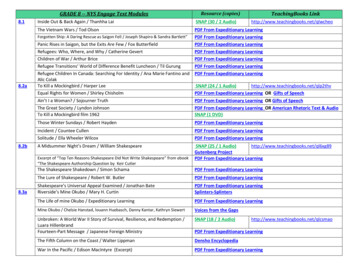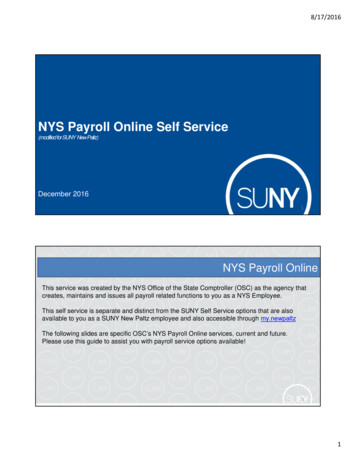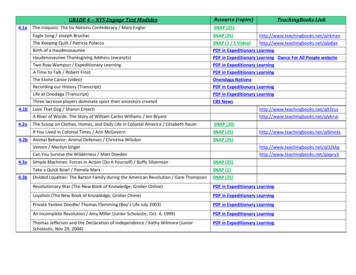
Transcription
GRADE 8 -- NYS Engage Text Modules8.18.2bSNAP (30 / 2 Audio)The Vietnam Wars / Tod OlsonPDF From Expeditionary LearningPDF From Expeditionary LearningPDF From Expeditionary LearningPDF From Expeditionary LearningPDF From Expeditionary LearningPDF From Expeditionary LearningPDF From Expeditionary LearningPanic Rises in Saigon, but the Exits Are Few / Fox ButterfieldRefugees: Who, Where, and Why / Catherine GevertChildren of War / Arthur BriceRefugee Transitions’ World of Difference Benefit Luncheon / Til GurungRefugee Children In Canada: Searching For Identity / Ana Marie Fantino andAlic ColakTo Kill a Mockingbird / Harper LeeEqual Rights for Women / Shirley Chisholmhttp://www.teachingbooks.net/qlwcheoSNAP (24 / 1 Audio)http://www.teachingbooks.net/qlp2thvPDF From Expeditionary Learning OR Gifts of SpeechAin’t I a Woman? / Sojourner TruthThe Great Society / Lyndon JohnsonTo Kill a Mockingbird film 1962PDF From Expeditionary Learning OR Gifts of SpeechPDF From Expeditionary Learning OR American Rhetoric Text & AudioSNAP (1 DVD)Those Winter Sundays / Robert HaydenPDF From Expeditionary LearningIncident / Countee CullenSolitude / Ella Wheeler WilcoxPDF From Expeditionary LearningPDF From Expeditionary LearningA Midsummer Night’s Dream / William ShakespeareSNAP (25 / 1 g ProjectPDF From Expeditionary LearningExcerpt of “Top Ten Reasons Shakespeare Did Not Write Shakespeare” from ebook“The Shakespeare Authorship Question by Keir Cutler8.3aTeachingBooks LinkInside Out & Back Again / Thanhha LaiForgotten Ship: A Daring Rescue as Saigon Fell / Joseph Shapiro & Sandra Bartlett”8.2aResource (copies)The Shakespeare Shakedown / Simon SchamaPDF From Expeditionary LearningThe Lure of Shakespeare / Robert W. ButlerPDF From Expeditionary LearningShakespeare’s Universal Appeal Examined / Jonathan BateRiverside’s Mine Okubo / Mary H. CurtinPDF From Expeditionary LearningSplinters-SplintersThe Life of mine Okubo / Expeditionary LearningPDF From Expeditionary LearningMine Okubo / Chelsie Hanstad, louann Huebasch, Danny Kantar, Kathryn SiewertVoices from the GapsUnbroken: A World War II Story of Survival, Resilience, and Redemption /Luara HillenbrandFourteen-Part Message / Japanese Foreign MinistrySNAP (18 / 2 Audio)The Fifth Column on the Coast / Walter LippmanDensho EncyclopediaWar In the Pacific / Edison MacIntyre (Excerpt)PDF From Expeditionary Learninghttp://www.teachingbooks.net/qlcsmaoPDF From Expeditionary Learning
GRADE 8 -- NYS Engage Text Modules (con’t)8.3acon’t8.3b8.4Resource (copies)TeachingBooks LinkReport on Japanese on the West Coast of the United States (The MunsonReport) / Curtis b. MunsonExecutive Order No. 9066 / Franklin d. RooseveltDenscho EncyclopediaA Mighty Long Way: My Journey to Justice at Little Rock Central HighSchool / Carlotta Walls LaNierPlessy v. Ferguson, Supreme Court caseSNAP(25/1 Audio)Little Rock Girl 1957: How a Photograph Changed the Fight for Integration/Shelley Tougas14th Amendment to the U.S. constitutionSNAP(25)Video Overview: Plessy v. Ferguson / Christian BryantAbout.comJim Crow Laws / National Park ServiceNational Park ServiceAddress to the first Montegomery Improvement Associat (MIA) massMeeting (Montgomery bus boycott) / Martin Luther King, JrI have a Dream / Dr. martin Luther King, Jr.Kingencyclopedia.stanford.eduJohn Chancellor reports on the integration at Central High School / BNC NewsNBC LearnBrown v. Board of EducationPBS documentaryThe Editorial Position of the Arkansas Gazette in the Little Rock SchoolCrisis / University of Arkansas LibrariesThe Omnivore’s Dilemma / Michael PollanUniversity of ArkansasUnit I: Reading Closely for Textual Details: We Had to Learn EnglishUnit II: Making Evidence-Based Claims Unit: Truth, Chisholm, WilliamsUnit III: Researching to Deepen Understanding Unit: Human-Animal InteractionUnit IV: Building Evidence-Based Arguments Unit: E Pluribus UnumOur Documentshttp://www.teachingbooks.net/qln8n5aOur Documentshttp://www.teachingbooks.net/qljwnwpOur DocumentsAmerican RhetoricSNAP (25) EReaders (48)http://www.teachingbooks.net/qlnev8n
GRADE 8: MODULE 1: UNIT 1: LESSON 6Map of AsiaCreated by Expeditionary Learning, on behalf of Public Consulting Group,Inc. Public Consulting Group, Inc., with a perpetual license granted toExpeditionary Learning Outward Bound, Inc.NYS Common Core ELA Curriculum G8:M1:U1:L6 June 2014
GRADE 8: MODULE 1: UNIT 1: LESSON 6“The Vietnam Wars”By the time American troops arrived on their shores, the Vietnamese had already spent centuries honing awarrior tradition in a series of brutal wars.By Tod OlsonThe Chinese Dragon208 B.C.-1428 A.D.In Vietnam, a nation forged in the crucible of war, it is possible to measure time by invasions. Longbefore the Americans, before the Japanese, before the French even, there were the Chinese. They arrived inthe 3rd century B.C. and stayed for more than 1,000 years, building roads and dams, forcing educatedVietnamese to speak their language, and leaving their imprint on art, architecture and cuisine.The Chinese referred to their Vietnamese neighbors as Annam, the “pacified south,” but theVietnamese were anything but peaceful subjects. Chafing under Chinese taxes, military drafts, and forcedlabor practices, they rose up and pushed their occupiers out again and again, creating a warrior traditionthat would plague invaders for centuries to come.The struggle with China produced a string of heroes who live on today in street names, films, and literature.In 40 A.D., the Trung sisters led the first uprising, then drowned themselves rather than surrender whenthe Chinese returned to surround their troops. Two centuries later, another woman entered the pantheonof war heroes. Wearing gold-plated armor and riding astride an elephant, Trieu Au led 1,000 men intobattle. As she faced surrender, she too committed suicide. In the 13th century, Tran Hung Dao used hit-andrun tactics to rout the Mongol emperor Kublai Khan. His strategy would be copied 700 years later againstthe French, with momentous results.Finally, in the 15th century, a hero arose to oust the Chinese for good. Le Loi believed – as didgenerations of warriors to follow – that political persuasion was more important than military victories.According to his poet/adviser, Nguyen Trai, it was “better to conquer hearts than citadels.” In 1428, Le Loideployed platoons of elephants against the Chinese horsemen, and forced China to recognize Vietnameseindependence. Gracious in victory, Le Loi gave 500 boats and thousands of horses to the Chinese andushered them home. Except for a brief, unsuccessful foray in 1788, they did not return.From SCHOLASTIC UPDATE. Copyright 1995 by Scholastic Inc. Reprinted by permission of Scholastic Inc.Copyright 1995 by Scholastic, Inc. Used by permission and not subject to CreativeCommons license.NYS Common Core ELA Curriculum G8:M1:U1:L6 June 2014
GRADE 8: MODULE 1: UNIT 1: LESSON 6“The Vietnam Wars”“Everything Tends to Ruin”1627-1941In 1627, a young white man arrived in Hanoi, bearing gifts and speaking fluent Vietnamese. FatherAlexandre de Rhodes devoted himself to the cause that had carried him 6,000 miles from France toVietnam: “saving” the souls of the non-Christian Vietnamese. He preached six sermons a day, and in twoyears converted 6,700 people from Confucianism to Catholicism. Vietnam’s emperor, wary that theFrenchman’s religion was just the calling card for an invasion force, banished Rhodes from the country.Two centuries later, the French proved the emperor right. In 1857, claiming the right to protectpriests from persecution, a French naval force appeared off Vietnamese shores. In 26 years, Vietnam was aFrench colony.The French turned the jungle nation into a money-making venture. They drafted peasants toproduce rubber, alcohol, and salt in slavelike conditions. They also ran a thriving opium business andturned thousands of Vietnamese into addicts. When France arrived in Vietnam, explained Paul Doumer,architect of the colonial economy, “the Annamites were ripe for servitude.”But the French, like the Chinese before them, misread their colonial subjects. The Vietnamesespurned slavery, and organized a determined resistance, using their knowledge of the countryside to outwitthe French. “Rebel bands disturb the country everywhere,” complained a French commander in Saigon.“They appear from nowhere in large numbers, destroy everything, and then disappear into nowhere.”From SCHOLASTIC UPDATE. Copyright 1995 by Scholastic Inc. Reprinted by permission of Scholastic Inc.Copyright 1995 by Scholastic, Inc. Used by permission and not subject to CreativeCommons license.NYS Common Core ELA Curriculum G8:M1:U1:L6 June 2014
GRADE 8: MODULE 1: UNIT 1: LESSON 6 “The Vietnam Wars”French colonial officials made clumsy attempts to pacify the Vietnamese. They built schools andtaught French culture to generations of the native elite, only to find that most Vietnamese clung proudly totheir own traditions. When persuasion failed, the French resorted to brutality. But executions only createdmartyrs for the resistance and more trouble for the French. As one French military commander wrote withforeboding before returning home: “Everything here tends to ruin.”Life, Liberty, and Ho Chi Minh1941-1945Early in 1941, a thin, taut figure with a wispy goatee disguised himself as a Chinese journalist andslipped across China’s southern border into Vietnam. In a secluded cave just north of Hanoi, he met withhis comrades in Vietnam’s struggle for independence. The time was ripe, he told them. In the tumult ofWorld War II, the Japanese had swept through most of Southeast Asia, replacing the French in Vietnamwith their own colonial troops. The Vietnamese, he said, must help the Western Allies defeat Japan. Inreturn, the British and Americans would help Vietnam gain independence after the war. In the dim light ofthe cave, the men formed the Vietnam Independence League, or Vietminh, from which their fugitive leadertook the name that would plague a generation of generals in France and the United States: Ho Chi Minh.By 1941, Ho was known as a fierce supporter of Vietnamese independence. For 30 years he haddrifted from France to China, to the Soviet Union, preaching Communism and nationalism to Vietnameseliving abroad. When he returned to Vietnam, his frugal ways and his devotion to the cause won him aninstant following.With American aid, Ho directed guerrilla operations against the Japanese. In August 1945, Japansurrendered to the Allies. A month later, Ho mounted a platform in Hanoi’s Ba Dinh Square, wherelanterns, flowers, banners, and red flags announced the festive occasion. Quoting directly from theAmerican Declaration of Independence, he asserted that all men have a right to “life, liberty, and thepursuit of happiness.” Then, while the crowd of hundreds of thousands chanted “Doc-Lap, Doc-Lap” –independence – Ho declared Vietnam free from 62 years of French rule.From SCHOLASTIC UPDATE. Copyright 1995 by Scholastic Inc. Reprinted by permission of Scholastic Inc.Copyright 1995 by Scholastic, Inc. Used by permission and not subject to CreativeCommons license.NYS Common Core ELA Curriculum G8:M1:U1:L6 June 2014
GRADE 8: MODULE 1: UNIT 1: LESSON 6 “The Vietnam Wars”The Fall of the French1945-1954The Vietnamese, their hopes kindled by the excitement of the moment, soon found thatindependence would not come as easily as elegant speeches. In 1945, French troops poured into thecountry, determined to regain control of the colony.Ho, meanwhile, consolidated power, jailing or executing thousands of opponents. He also appealedseveral times for U.S. help, but to no avail. Determined to fight on, Ho told French negotiators, “If we mustfight, we will fight. We will lose 10 men for every one you lose, but in the end it is you who will tire.”In the winter of 1946-1947, the French stormed Hanoi and other cities in the North. Hopelesslyoutgunned, Ho’s troops withdrew to the mountains. Led by General Vo Nguyen Giap, the Vietminhharassed the French soldiers with a ragtag array of antique French muskets, American rifles, Japanesecarbines, spears, swords, and homemade grenades. Moving through familiar terrain, supported by anetwork of friendly villages, the Vietnamese struck, then disappeared into the jungle.By 1950, the French war in Vietnam had become a battleground in a much larger struggle. China,where revolution had just brought Communists to power, and the Soviet Union were supplying theVietminh with weapons. The U.S., committed to containing the spread of Communism, backed the French.Even 2.5 billion of U.S. aid did not keep the French from wearing down, just as Ho had predicted.The final blow came in 1954, when General Giap surrounded 15,000 French troops holed up near theremote mountain town of Dien Bien Phu. After two months of fighting in the spring mud, the French wereexhausted and Dien Bien Phu fell. Reluctantly, they agreed to leave Vietnam for good.From SCHOLASTIC UPDATE. Copyright 1995 by Scholastic Inc. Reprinted by permission of Scholastic Inc.Copyright 1995 by Scholastic, Inc. Used by permission and not subject to CreativeCommons license.NYS Common Core ELA Curriculum G8:M1:U1:L6 June 2014
GRADE 8: MODULE 1: UNIT 1: LESSON 6 “The Vietnam Wars”Doc-Lap at Last1954-1975The Americans cringed at the thought of a Communist Vietnam, and picked up where the French leftoff. A peace accord temporarily divided Vietnam in half, promising elections for the whole country by 1956.With Ho in full control of the North, the Americans backed a French-educated anti-Communist named NgoDinh Diem in the South.As President, Diem managed to alienate everyone, arresting thousands of dissidents andcondemning scores to death. In 1956, he was accused of blocking the elections, adding fuel to a growingbrushfire of rebellion.The U.S. responded by pumping money into Diem’s failed regime and sending military “advisers,”many of whom were unofficially engaged in combat. Then, on August 2, 1964, reports reached Washingtonalleging that three North Vietnamese boats had attacked the U.S.S. Maddox on patrol in Vietnam’s TonkinGulf. The U.S. went to war, though the reports were later disputed.In 1965, American bombers struck North Vietnam in a fearsome assault, designed to break the willof the people. But the North refused to surrender.Meanwhile, in the South, Communist rebels, called the Viet Cong, operated stealthily under cover ofthe jungle. With aid from the North, they laid mines and booby traps, and built networks of secret supplyroutes. Like the French before them, U.S. troops – some 500,000 strong by 1968 – pursued their elusiveenemy in ways that alienated the people they were supposed to be saving. They burned villages suspected ofharboring Viet Cong and sprayed chemicals to strip the jungle of its protective covering. By 1968, 1 out ofevery 12 South Vietnamese was a refugee.On January 30, 1968, the Vietnamese celebrated Tet, their New Year, with fireworks and parties. Butas darkness fell, a surprise attack interrupted the revelry. More than 80,000 Viet Cong and NorthVietnamese troops stormed major cities and even the U.S. Embassy in Saigon.U.S. troops turned back the so-called Tet Offensive. But the American people, tiring of an expensiveand seemingly fruitless conflict, turned against the war. President Richard M. Nixon took office in 1969amid a rising tide of antiwar sentiment. He agreed to begin pulling out of Vietnam. It took four more yearsof fighting and thousands more casualties, but in March 1973, the last U.S. troops withdrew.Two years later, on April 30, 1975, columns of North Vietnamese soldiers entered Saigon, meetinglittle resistance from the demoralized South Vietnamese army. The last American officials fought their wayonto any aircraft available and left Vietnam to the Communists. Ho Chi Minh, who had died in 1969, didnot live to see the moment. After years of struggle, Vietnam had been unified – but by force and at the costof millions dead.From SCHOLASTIC UPDATE. Copyright 1995 by Scholastic Inc. Reprinted by permission of Scholastic InCopyright 1995 by Scholastic, Inc. Used by permission and not subject to CreativeCommons license.NYS Common Core ELA Curriculum G8:M1:U1:L6 June 2014
GRADE 8: MODULE 1: UNIT 1: LESSON 13ATTACHMENT ATranscript of “Forgotten Ship: A Daring Rescue As Saigon Fell,”NPR’s All Things Considered, August 31, 2010MELISSA BLOCK, host: From NPR News, this is ALL THINGSCONSIDERED. I'm Melissa Block.ROBERT SIEGEL, host: And I'm Robert Siegel.When the Vietnam War ended and Saigon fell in April 1975, Americansgot their enduring impression of the event from television But there was another evacuation that didn't get news coverage. U.S.Navy ships saved another 20 to 30,000 Vietnamese refugees.BLOCK: The full scope of this humanitarian rescue has been largelyuntold, lost in time and in bitterness over the Vietnam War.But correspondent Joseph Shapiro and producer Sandra Bartlett, fromNPR's investigative unit, interviewed more than 20 American andVietnamese eyewitnesses. And they studied hundreds of documents,photographs and other records, including many never made public before.Here's Joseph Shapiro with part one of our report and the story of onesmall U.S. Navy ship.JOSEPH SHAPIRO: On the morning of April 29, 1975, the USS Kirk andits crew stood off the coast of South Vietnam in the South China Sea.(Soundbite of a 1975 tape)Mr. HUGH DOYLE (Then-Chief Engineer, USS Kirk): I'm sure as youknow by this time, Vietnam has surrendered and the mass panic - almostpanic-stricken retreat has already taken place.SHAPIRO: Sitting on his bunk, the ship's chief engineer, Hugh Doyle,records a cassette tape to send home to his wife, Judy.(Soundbite of a 1975 tape)Mr. DOYLE: I really don't know where to start. It's been such an unusualcouple of days. Where we fit in was really interesting. You're probably notgoing to believe half the things I tell you. But believe me, they are all true.SHAPIRO: Doyle's cassette tapes, which until now have never been heardpublicly, provide one of the best accounts of one of the most extraordinaryhumanitarian missions in the history of the U.S. Navy.Copyright 2010 National Public Radio, Inc. Used by permission and not subject toCreative Commons license.NYS Common Core ELA Curriculum G8:M1:U1:L13 May 2014
GRADE 8: MODULE 1: UNIT 1: LESSON 13The Kirk's military mission that day was to shoot down any NorthVietnamese jets that might try to stop U.S. Marine helicopters, as theyevacuated people from Saigon. The North Vietnamese planes nevercame. But the Kirk's mission was about to change, and suddenly.Doyle told Judy what he and his crewmates saw when they looked towardSouth Vietnam, some 12 miles away.(Soundbite of a 1975 tape)Mr. DOYLE: We looked up at the horizon, though, and pretty soon all youcould see were helicopters. And they came and just was incredible. I don'tthink I'll ever see anything like it again.Mr. PAUL JACOBS (Then-Captain, USS Kirk): It looked like bees flying allover the place. Yeah, trying to find some place to land.SHAPIRO: Paul Jacobs was captain of the Kirk.Mr. JACOBS: Every one of those Hueys probably had 15 or 20 on board.But they're all headed east, you know, trying to escape.SHAPIRO: Kent Chipman, a 21-year-old Texan, worked in the engineroom.Mr. KENT CHIPMAN (Then-Crewman, USS Kirk): What was freaky andit's still - it gives me goose bumps till today, it'd be real quiet and calm andnot a sound, and then all of a sudden you could hear the helicopterscoming. They just - you can hear the big choop-choop-choo-choop, youknow, the Hueys.SHAPIRO: These were South Vietnamese Huey helicopters. Military pilotshad crammed their aircraft with family and friends and flown out to theSouth China Sea. They were pretty sure that the U.S. Navy 7th Fleet wasin that ocean somewhere. Now they were desperately looking for someplace to land.Here's Hugh Doyle speaking today.Mr. DOYLE: Well, they were flying out to sea. Some of them were very lowon fuel and some of them were crashing alongside the larger ships. Theywould crash in the water, and I don't know how many Vietnameserefugees were lost in all that.SHAPIRO: But the helicopters flew past the Kirk. They were looking for alarger carrier deck to land. Jim Bondgard(ph), a radar man, was watchingall the traffic dotting the radarscope when Captain Jacobs issued orders.Copyright 2010 National Public Radio, Inc. Used by permission and not subject toCreative Commons license.NYS Common Core ELA Curriculum G8:M1:U1:L13 May 2014
GRADE 8: MODULE 1: UNIT 1: LESSON 13Mr. JIM BONDGARD (Crewman, USS Kirk): The skipper got real excited.He called down to us and said, you need to try to advertise and see if youcan get these guys on the radio. Just announcing where our haul numberand we have an open flight deck; if you want to come land on us, we cantake you aboard, and that kind of thing. You know, just trying to encouragethem to come in.SHAPIRO: There was one problem: It wasn't clear that the pilots couldland on a moving ship.Don Cox was an anti-submarine equipment officer.Mr. DON COX (Crewman, USS Kirk): Most of the Vietnam pilots hadnever landed on board a ship before. Almost to a man they were armypilots and they typically landed either at fire zones, they had little clearingsin the brush, or at an airport. And the ship looks very, very small and thedeck was very crowded.SHAPIRO: Cox was one of the sailors who, not sure if those pilots wouldland or crash, stood on the flight deck to direct the helicopters in.The first two helicopters landed safely, but then there was no more room.The Kirk was a destroyer escort. It was built to hunt submarines, not landhelicopters. It had a landing deck about the size of a tennis court.Mr. COX: I believe it was the third aircraft landed and chopped the tail offthe second aircraft that had landed. There were still helicopters circlingwanting to land. There was no room on our deck, so we just startedpushing helicopters overboard. We figured humans were much moreimportant than the hardware.(Soundbite of a 1975 tape)Mr. DOYLE: So we couldn't think of what else to do. And these otherplanes were looking for a place to land. And, you know, we would havelost people in the plane so we threw the airplane over the side. Yeah,really.SHAPIRO: As one helicopter landed and the people scrambling off,dozens of sailors ran over to push the aircraft over the side and into theocean.But Kent Chipman says it wasn't easy. Vietnamese helicopters wereheavy. And because they were designed to land in fields, they had skidsinstead of wheels.Mr. CHIPMAN: The flight deck has non-skid on it. I mean, it's like realrough sandpaper. And the Hueys didn't have tires on. They had like skids.Copyright 2010 National Public Radio, Inc. Used by permission and not subject toCreative Commons license.NYS Common Core ELA Curriculum G8:M1:U1:L13 May 2014
GRADE 8: MODULE 1: UNIT 1: LESSON 13And we had to just work it this way and work it that way, till we got it overto the edge. And then everybody there'd be like 30 people just fightingtheir way to get over there and try to help, you know.SHAPIRO: With one final shove, the helicopter would totter over the edgeof the ship, with its tail high in the air and then crash to the water below.(Soundbite of a 1975 tape)Mr. DOYLE: There were stories, horrible stories that I've heard from theserefugees.SHAPIRO: One Vietnamese pilot landed with bullet holes in his aircraft.Hugh Doyle saw he was in shock.(Soundbite of a 1975 tape)Mr. DOYLE: As he was loading his helicopter, had his family killed.They're standing waiting to get on the helicopter, his family was machinegunned. He was just sitting in the helicopter. He was the pilot. He stoodthere and looked at them. They were all laying dead.SHAPIRO: The crew of the Kirk fed the refugees and spread out tarps toprotect them from the blazing sun.Mr. DOYLE: We took the people up on to the 02-Level, it be just behindour stack, and we laid mats and all kinds of blankets and stuff out on thedeck for their babies. And there were all kinds of - there were infants andchildren and women, and the women were crying. And, oh, it was a sceneI'll never forget.SHAPIRO: Kent Chipman.Mr. CHIPMAN: These people were coming out of there with nothing whatever they had in their pockets or hands. Some of them had suitcases.Some of them had a bag. You know, and you could tell they'd been in awar. They were still wounded. There were people young, old, army guyswith the bandages on their head, arms - you could tell they'd been in afight.Some of the pilots and their families came from Vietnam's elite, and someof them carried what was left of their wealth in wafers of gold, sometimessewn into their clothes. The captain locked the gold in his safe.Then there was the helicopter that was too big to land.Mr. CHIPMAN: This is when the big Chinook came out. And you could tellthe sound of it was different; more robust, deep.Copyright 2010 National Public Radio, Inc. Used by permission and not subject toCreative Commons license.NYS Common Core ELA Curriculum G8:M1:U1:L13 May 2014
GRADE 8: MODULE 1: UNIT 1: LESSON 13(Soundbite of a 1975 tape)Mr. DOYLE: This huge helicopter called a Chinook. It's a Boeing. Youknow, remember them from my mother's house on Berthold Place? Soyou know those huge helicopters they made down there - those great bigones?SHAPIRO: Doyle had grown up in Pennsylvania, near the factory thatmade those helicopters.(Soundbite of a 1975 tape)Mr. DOYLE: They came out and tried to land on the ship. Oh, we almost the thing almost crashed on board our ship. So we finally got them torealize to wave them off, it was too big. You know, he just could not havelanded. Well, he flew around us a couple of times and he was running lowon fuel. Picture this: we're steaming along at about five knots and thishuge airplane comes in and hovers over the fantail, opened up its reardoor and started dropping people out of it. And this is about 15 feet off thefantail.There's American sailors back on the fantail catching babies likebasketballs.Mr. CHIPMAN: The helicopter, it wasn't stationary. It'd come in and hoverand, you know, trying to get close as they could. And I remember, at leasttwice, that he went back up - not real high, you know, 60 feet or so - andhe'd slowly come back down.The helicopter was probably eight to 10 foot in the air as - off the deck, aswe were catching the people jumping out. Then we kind of scooch out tothe door and just kind of drop down, you know, as easily as they could.This - I mean, juts the noise is tremendous. It's the biggest Chinook theymake with the four sets wheels. The wind off this thing, it's like being in ahurricane.SHAPIRO: One mother dropped her baby and her two young childrentoward the outstretched arms of the sailors below.Mr. CHIPMAN: I remember the baby coming out. You know, there was noway we were going to let them hit the deck or drop them. We caught them.I was pretty small myself back then - weighed 130 pounds. Even as smallas I am, you know, they come flying out and we caught them.SHAPIRO: These were the Vietnamese army pilots' children. He'd savedthe lives of his passengers, but now he was out of fuel and surrounded byCopyright 2010 National Public Radio, Inc. Used by permission and not subject toCreative Commons license.NYS Common Core ELA Curriculum G8:M1:U1:L13 May 2014
GRADE 8: MODULE 1: UNIT 1: LESSON 13flat, blue ocean. Hugh Doyle saw him fly the huge helicopter about 60yards from the Kirk. Doyle uses slang and calls it an airplane.Mr. DOYLE: He took the airplane, hovered it very close to the water, tookall his clothes off with the exception of his skivvies, all by himself, no copilot, took all his clothes off, threw it out the window. And then he got upon the edge of the window, still holding onto the two sticks that ahelicopter has to fly with. He tilted it over on its side, still flying in the air,and dove into the water. The airplane just fell into the water. It hit thewater on its right-hand side. The rotors just exploded.Mr. CHIPMAN: There were small pieces, but there were also pieces,probably 10, 15 foot long, big pieces go flying out - it sounded like a gianttrain wreck, you know, in slow motion, and it's loud, it's, you know, windblowing everywhere.The Chinook ended upside down. He dove out the side of it, the thingflipped upside down, and then it was calm and quiet again like you turnedoff a light switch.I'm thinking, man, this guy just died. I said this is crazy. And his little headpopped out of the water. I said, he's alive. It was pretty cool.SHAPIRO: The pilot's name was Ba Nguyen. He and his family wereamong some 200 refugees rescued from 16 helicopters. On the secondday those refugees, more than half were women, children and babies,would be moved to a larger transport ship.But the heroics of the Kirk would continue. Shortly before midnight, at theend of the second day, the Kirk's captain, Paul Jacobs, got a call.Mr. PAUL JACOBS: And that's when I got a (knocking sound) on theshoulder from the XO. He says, hey, Seventh Fleet wants to speak to younow. It's urgent.SHAPIRO: It was the admiral in charge of the entire rescue.Mr. JACOBS: He says we're going to have to send you back to rescue theVietnamese navy. We forgot them, and if we don't get them or any part ofthem, they're all probably going to be killed.SHAPIRO: The Kirk was being sent back to Vietnam. The SouthVietnamese government had fallen; the Communists were in control now.The Kirk would be headed into hostile territory by itself.Copyright 2010 National Public Radio, Inc. Used by permission and not subject toCreative Commons license.NYS Common Core ELA Curriculum G8:M1:U1:L13 May 2014
GRADE 8: MODULE 1: UNIT 1: LESSON 13Mr. JACOBS: So I s
Panic Rises in Saigon, but the Exits Are Few / Fox Butterfield PDF From Expeditionary Learning Refugees: Who, Where, and Why / Catherine Gevert PDF From Expeditionary Learning Children of War / Arthur Brice PDF From Expeditionary Learning Refugee Transitions' World of Difference enefit Luncheon / Til Gurung PDF From Expeditionary Learning











